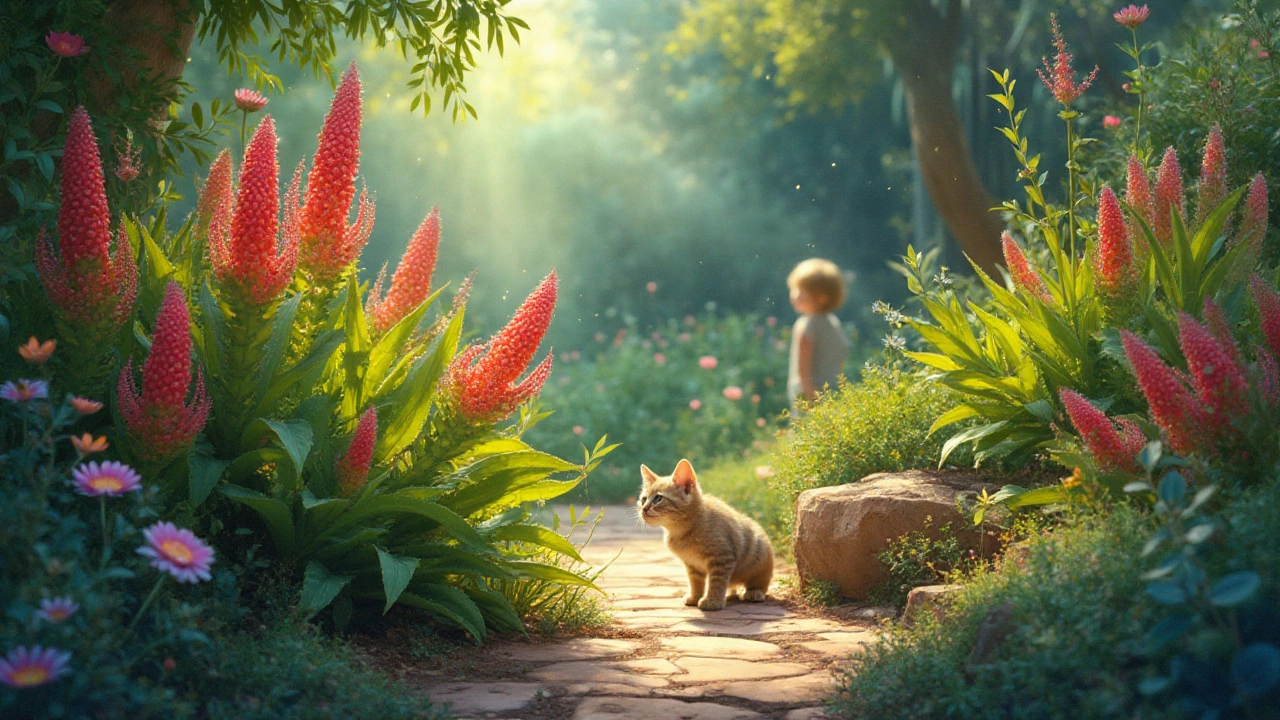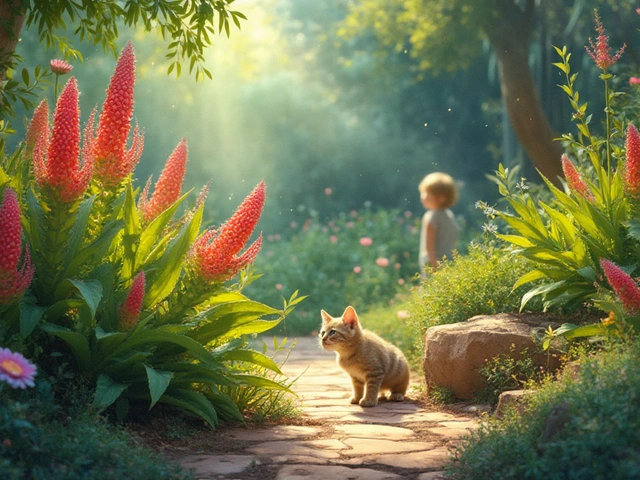The succulent world offers a captivating array of wonders, with the Mother of Thousands standing out as both a darling and a dilemma. This exotic plant, known scientifically as Kalanchoe daigremontiana, charms with its curious ability to propagate tiny plantlets from the edges of its leaves. However, whispers of its toxicity have sown seeds of doubt among gardening enthusiasts and pet owners alike. Before you welcome this fascinating friend into your green space, it's prudent to dive deep into what makes it both a blessing and a burden.
As we unravel the story behind the Mother of Thousands, a few pressing questions arise. Is it truly hazardous to humans? How do you balance its beauty with safety, especially in homes bustling with children or pets? Let's explore these facets and uncover how you can harmonize the allure of this plant with responsible gardening practices.
- Introduction to Mother of Thousands
- Understanding Its Toxicity
- Effects on Humans
- Precautionary Measures
- Safe Gardening Practices
- Creative Uses and Alternatives
Introduction to Mother of Thousands
The Mother of Thousands, lovingly nicknamed due to its remarkable ability to reproduce, belongs to the Crassulaceae family and originates from Madagascar. Its scientific moniker, Kalanchoe daigremontiana, pays homage to its discoverer's adventurous botanical pursuits in the early 20th century. Characterized by its broad, green leaves bordered with tiny plantlets, this succulent captures the imagination with its self-sustaining reproduction method. These plantlets develop from notches along the leaf edges, readily dropping off and rooting wherever they find conducive soil. It's as though nature designed the plant with the ingenuity of a well-tuned factory, mass-producing its next generation with unparalleled efficiency.
What makes the Mother of Thousands particularly beguiling is not only its reproductive vigour but also its resilience. It's a plant that seems to thrive on neglect, perfectly suited for busy gardeners who adore green life without the constant fuss. Able to flourish in diverse environments, it requires minimal intervention, usually just bright, indirect light and well-draining soil to keep its lush charm. But as enchanting as this succulent may be, some might find its enthusiasm for propagation overwhelming. Left unchecked, it can swiftly colonize and outcompete other flora, turning a mixed border into a monogamous scene. Indeed, its vigor is both its greatest asset and a gardener’s delicate challenge.
Beyond its horticultural prowess, the Mother of Thousands presents a broader ecological narrative. With traditional uses in indigenous medicine, some cultures have harnessed its properties to treat fevers, blisters, and wounds. Although modern science demands rigorous validation of such claims, the lore surrounding this plant adds layers to its mystique. "The Kalanchoe species have been studied for their intriguing biochemical profiles," notes Dr. Sylvia Whittaker, a plant biochemist whose research seeks to unravel their pharmacological mysteries.
The balance between traditional knowledge and scientific exploration drives much of our understanding of plant-based medicine
To fully appreciate the potential of the Mother of Thousands in a garden, one must also consider its aesthetic contributions. With a keen eye for artful arrangements, gardeners can craft dramatic displays using these plants, interspersed with rocks and other xerophytes, to mimic their native habitats. Combating its rapid spread can involve container planting, effectively curbing its wanderlust while accentuating its architectural beauty in minimalist settings. Such approaches not only showcase the plant's elegance but also align with sustainable gardening principles, mindful of biodiversity and ecosystem balance. By embracing both its allure and assertive nature, the Mother of Thousands can become a gem in the crown of any garden enthusiast willing to manage its quirks and cherish its gifts.
Understanding Its Toxicity
The Mother of Thousands, with its botanical name Kalanchoe daigremontiana, has long been admired for its intriguing foliage and prolific nature. However, its allure comes with a cautionary tale of toxicity that gardeners need to understand. This succulent is part of the Crassulaceae family which houses several species known for their toxic properties. In particular, the plant contains compounds known as bufadienolides, which are cardiac glycosides. These substances can interfere with the heart muscle's normal functions if ingested. While the plant's danger levels vary between species, the consensus is clear – caution is key when handling or positioning this plant around children and pets.
The bufadienolides in the Mother of Thousands are believed to act at a cellular level, posing significant risks if consumed in quantity. Such compounds can induce nausea, vomiting, and diarrhea in humans, while potentially causing more severe symptoms in children, due to their smaller body weight and higher susceptibility. In rare circumstances, significant ingestion may lead to heart complications given these compounds' effect on cardiac function. Although documented cases of human poisoning are scarce, pets have reportedly fallen victim to its toxic nature. This culmination of evidence advises gardeners to deliberate over its placement with thoughtful prudence.
A study published in the Journal of Veterinary Diagnostic Investigation in 2019 highlighted the widespread concern for pet safety regarding this plant, underscoring its potentially fatal effects when ingested by small animals.
Despite its capacity for harm, scenarios of severe human reaction are notably rare. The risk grows chiefly in environments where awareness is lacking or when continual exposure is possible. Knowledge and conscientious handling can negate most concerns, effectively reducing risks to negligible levels. Understanding these implications underscores the importance of informed decisions when introducing this captivating plant into homes. Whether coaxing it to thrive on a windowsill or integrating it into a curated landscape, knowledge is your best ally against unwanted surprises. The intricacies of its interaction with humans showcase nature’s delicate balances, urging a respectful approach to cultivation.
Effects on Humans
For the aspiring gardener or plant lover, understanding the specific potential hazards associated with the Mother of Thousands is crucial. This intriguing plant contains compounds known as bufadienolides, a type of steroid that can be toxic if ingested. While its allure is undeniable, direct interaction often raises safety concerns, particularly in households with young children. Instances of poisoning can exhibit symptoms such as nausea, vomiting, and diarrhea. In severe cases, more serious symptoms like heart palpitations or arrhythmias have been reported. Despite the stunning appearance of this plant, it’s essential to be vigilant, ensuring safety is a priority without diminishing the enjoyment it brings to one's home.
Given its potential risks, parents and caregivers might wonder if it's wise to keep such a plant around. The potential for oral ingestion by curious children leads many to err on the side of caution. However, recorded cases indicate that significant poisoning in humans is relatively rare due to the typically bitter taste of the plant, which deters substantial consumption. Dr. Sylvia Garey, toxicologist at a leading botanical institute, remarked, "The Kalanchoe genus, while visually stunning, should be appreciated with due respect for its chemical compositions." Mostly, it's about the balance of tending to plants while ensuring they are placed out of the easy reach of children.
Even in environments absent of children, awareness remains key due to the plant's propensity to disperse its seeds liberally. Precautionary measures should also extend to areas where food preparation occurs, as accidental contamination remains a risk. It's wise to wash hands thoroughly after handling the plant, to prevent any tracing of its sap to consumable items. Given the plant's resilience, it would thrive in a spot that's visually accessible but physically out of range, such as a high shelf or a dedicated greenhouse area. With careful management, one can mitigate the impact of any potential adverse effects on humans while continuing to enjoy the plant's unique beauty.
Lastly, for those deeply concerned about safety yet enamored with the plant's unique aesthetic, considering alternatives might not be unwarranted. Many succulents evoke similar visual appeal and safe handling. Those trying to strike a balance could explore these options while still nourishing their love for botanical splendor. What matters most is informed decisions, particularly when it comes to integrating living, growing beings into the domestic landscape. Responsible plant ownership doesn't overwrite the joy of gardening; it essentially complements it.

Precautionary Measures
When welcoming the Mother of Thousands into your home or garden, there's an art to maintaining both its allure and ensuring safety. Understanding the plant's inherent toxicity is the first step toward crafting a balanced co-existence. Known for the potent compounds called bufadienolides, the plant poses risks if ingested, making precautionary measures a top priority for families with curious toddlers or pets. Rather than steering clear, knowledge is your safeguard.
Ensuring that this plant thrives without threat necessitates a few strategic moves. Start by selecting locations inaccessible to children and pets. High shelves or dedicated terrariums serve as beautiful yet secure havens. Regular maintenance is equally crucial. Those tiny plantlets, adorable as they might seem, have a knack for wandering. Besides fostering neatness, routinely picking these plantlets prevents unintended propagation.
Donning gloves is a simple yet effective practice for peace of mind. While the Mother of Thousands doesn't harm by touch, gloves are a quintessential barrier for hypersensitive skin. During maintenance tasks like repotting or trimming, gloves can prevent irritation from plant saps or residues. Moreover, promoting awareness across household members ensures collective caution and reinforces precautionary protocols.
A household with hens or curious cats might find additional solace in demarcating zones. Implementing physical barriers like mesh screens or decorative fences keeps inquisitive noses at bay. For those who favor data-driven approaches, consider consulting botanical safety guides or florists for updated safety statistics. According to a 2023 botanic survey, plants like the Mother of Thousands account for less than 5% of household plant-related incidents with adequate precautions in place.
"In the dance of nature and nurture, knowledge equips us to embrace beauty without peril," reflects Dr. Rose Lin, esteemed horticulturist.
Included in your precautionary toolkit should be emergency contacts dedicated to plant-related inquiries, just as a backup. CPR for plants involves clear protocols and decisive action. Should you suspect ingestion, staying calm becomes paramount. Quickly reaching out to a healthcare provider or a poison control center offers clarity and the best course of action. Through balanced measures, you can relish the elegance of the Mother of Thousands while keeping peace at home.
Safe Gardening Practices
Incorporating Mother of Thousands into your garden requires mindful preparation and a focus on safety. To start, consider locating this eye-catching succulent in areas that are less accessible to children and pets. Raised planters or hanging baskets can serve as effective barriers, allowing you to showcase its splendor without undue worry. It's essential to acknowledge that parts of the Kalanchoe can cause dermal irritation, especially for those with sensitive skin, so handling with gloves is a best practice. Keep soil well-draining to prevent root rot, while ensuring plantlets do not naturally propagate in unwanted areas.
One might wonder about balancing beauty with caution; the key lies in informed choices. Regular maintenance is pivotal, as trimming excess plantlets helps prevent uncontrolled spreading, often a common issue with this species. Stay attentive to the plant's health, ensuring it receives ample sunlight for robust growth, yet isn't scorched by overly intense rays. Many gardeners have found success using pot saucers to catch shed plantlets, preventing unintended rooting. “The beauty of sustainable gardening comes when one can maintain an equilibrium between flourishing flora and household safety,” noted renowned horticulturist Jane Goodall, reflecting on her experiences with adaptable houseplants.
Educating Your Household
Knowledge dissemination within the household is another vital component of safe gardening with potentially toxic plants. Host a family discussion to inform everyone about the plant's characteristics, emphasizing that it is not intended for consumption. Engage children with stories or books about succulents to capture their imagination while instilling respect for botanical boundaries. Consider labeling plants with clear markers that warn of potential risks, acting as visual reminders to deter unadvised interactions. Proactively designating specific areas as 'no-go zones' except under supervision encourages adherence to safety norms, particularly for the youngest members of a family.
Alternative Display Options
Sometimes, it's about shifting perspective. There are numerous creative display alternatives permitting the embrace of beauty without compromising safety protocols. Terrariums with secure covers can serve as delightful centerpieces, encasing the Mother of Thousands in a controlled microenvironment. Choose decorative containers that complement home decor and provide a conversation starter, all while containing the plant's adventurous offspring. Gardeners also explore integrating succulents into vertical living walls, though strategic placement must avoid sensitive touchpoints. In busier households, opting for artificial replicas might ensure peace of mind, leveraging botanical aesthetics without any health risks.
Ultimately, thoughtful application of safe gardening practices permits the harmonious inclusion of the enigmatic Mother of Thousands into your botanical collection. By taking protective measures, cultivating a knowledgeable environment, and exploring creative implementations, one can enjoy this botanical marvel while safeguarding all who reside within. The fusion of aesthetic enjoyment with practical caution demonstrates the gardener's mindful devotion to their craft, celebrating the coexistence of natural beauty and proactive care.
Creative Uses and Alternatives
The Mother of Thousands is much more than just a potential garden hazard; with a touch of creativity, it offers unique opportunities to enhance both indoor and outdoor spaces. Its architectural leaves and multiplying plantlets make it an intriguing choice for ornamental displays. Considered a conversation starter, this plant can be crafted into captivating living wall art or included in modern terrariums. This approach can breathe life into dull corners of a room, transforming minimalist displays into vibrant showcases. By placing it in a controlled environment, the risk factor of its toxicity can be minimized, making it a safer yet striking addition to your collection.
For those who prefer not to risk potential hazards, various alternatives exist that offer dramatic foliage without the concern of toxicity. Succulents like echeverias or crassulas provide gorgeous rosette shapes, while hoyas offer waxy leaves and fragrant blossoms. A more comprehensive look into suitable substitutes reveals options that harmonize aesthetics with safety. Cautiously exploring alternatives is essential, especially for those with curious children or pets. If you're aiming for greenery in indoor spaces, consider deploying ferns or the resilient spider plant, both of which are acclaimed for their air-purifying properties and non-toxic nature. By blending these with other easy-to-care-for succulents, you can achieve a lush arrangement that's both safe and visually appealing.
Venturing beyond visual appeal, many have embraced the Mother of Thousands for its array of medicinal uses. Traditionally, certain Kalanchoe species are utilized in folk medicine, credited with properties ranging from anti-inflammatory to wound healing. While modern science hasn't wholly substantiated these claims, they provide an interesting perspective on the plant's historical applications. Anecdotal evidence suggests that leaf extracts can be a remedy for minor ailments, though caution is advised due to the plant's natural toxicity. As with all herbal remedies, it's paramount to consult health professionals before delving into domestic healthcare experiments.
In a bid to understand its broader botanical impact, some enthusiasts document their cultivation practices, sharing insights and experiences. "Gardening, as a tranquil exercise, becomes a mindful meditation with each leaf nurtured," notes botanist Lisa Arkwright in her comprehensive guide to succulents. Keeping track of your gardening habits not only aids in the plant's prosperity but also constructs a knowledge base for future endeavors. Embrace the chance to discover the peculiar charm of the Mother of Thousands by experimenting with plant training techniques. Shaping it around frames or encouraging it to cascade from hanging pots presents an artistic expression of nature.
Explore the multitude of potential that this enigmatic plant presents in creating a compelling living collection while leveraging safer alternatives. The Mother of Thousands, with its distinctive allure, not only captivates but also challenges our gardening ingenuity. Whether as part of a diverse succulent medley or a solo spectacle, it calls for thoughtful arrangement and informed plant care. As you embark on this horticultural journey, let your creativity soar, blending artistry, safety, and nature in harmony.


